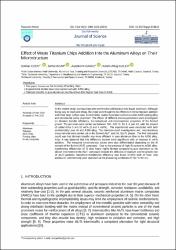| dc.contributor.author | Özer, Gökhan | |
| dc.contributor.author | Acar, Serhat | |
| dc.contributor.author | Kısasöz, Alptekin | |
| dc.contributor.author | Güler, Kerem Altuğ | |
| dc.date.accessioned | 2021-12-23T09:41:58Z | |
| dc.date.available | 2021-12-23T09:41:58Z | |
| dc.date.issued | 2021 | en_US |
| dc.identifier.citation | ÖZER, Gökhan, Serhat ACAR, Alptekin KISASÖZ & Kerem Altuğ GÜLER. "Effect of Waste Titanium Chips Addition Into the Aluminum Alloys on Their Microstructure". Gazi University Journal of Science, 34.4 (2021): 1096-1105. | en_US |
| dc.identifier.uri | https://dergipark.org.tr/tr/pub/gujs/issue/54905/819612 | |
| dc.identifier.uri | https://hdl.handle.net/11352/4004 | |
| dc.description.abstract | In the present study, turning chips were preferred to add titanium into liquid aluminum. Although being easy to reach and cheap, the chips were thought to be effective in minor titanium addition with their large surface area. Experimental studies have been carried out with A356 casting alloy and commercial purity aluminum. The effects of different process parameters were investigated on titanium transfer efficiency, microstructural and microhardness properties of the formed phases. The processes were carried out between 740 - 820 °C, for 2, 4, and 6 h, with the amount of added chips 5 and 10 wt.% (3 and 6 vol.%). The experiments were conducted with both commercially pure Al and A356 alloy. The microstructural investigations and microhardness measurements were carried out on the formed Al3Ti and (Al, Si)3Ti phases. The first noticeable result was that titanium transfer was more efficient in pure aluminum than in the A356 alloy. Also, it was observed that this difference became more significant with an increase in wt.% addition. The measured microhardness values were also differentiated depending on the Si content of the formed Al3Ti compound. Due to the presence of high Si content in A356 alloy, transference efficiencies of Ti were found highly limited compared to pure aluminum as the silicon enrichment in the Al3Ti compound reduces the diffusion of titanium and the growth rate of Al3Ti particles. Maximum transference efficiency was found 47.05% with 10 %wt. chip addition in commercially pure aluminum at the processing conditions of 780 °C for 4 h. | en_US |
| dc.language.iso | eng | en_US |
| dc.publisher | Gazi Üniversitesi | en_US |
| dc.relation.isversionof | 10.35378/gujs.819612 | en_US |
| dc.rights | info:eu-repo/semantics/openAccess | en_US |
| dc.subject | Aluminum | en_US |
| dc.subject | Titanium | en_US |
| dc.subject | Al3Ti /TiAl3 | en_US |
| dc.subject | Turning chips | en_US |
| dc.subject | In-situ composite | en_US |
| dc.title | Effect of Waste Titanium Chips Addition Into the Aluminum Alloys on Their Microstructure | en_US |
| dc.type | article | en_US |
| dc.relation.journal | Gazi University Journal of Science | en_US |
| dc.contributor.department | FSM Vakıf Üniversitesi, Rektörlük, Alüminyum Test Eğitim ve Araştırma Merkezi (ALUTEAM) | en_US |
| dc.contributor.authorID | https://orcid.org/ 0000-0001-5233-8896 | en_US |
| dc.contributor.authorID | https://orcid.org/ 0000-0003-1732-4995 | en_US |
| dc.contributor.authorID | https://orcid.org/ 0000-0001-8531-8162 | en_US |
| dc.contributor.authorID | https://orcid.org/ 0000-0002-3409-598X | en_US |
| dc.identifier.volume | 34 | en_US |
| dc.identifier.issue | 4 | en_US |
| dc.identifier.startpage | 1096 | en_US |
| dc.identifier.endpage | 1105 | en_US |
| dc.relation.publicationcategory | Makale - Uluslararası Hakemli Dergi - Kurum Öğretim Elemanı | en_US |
| dc.contributor.institutionauthor | Özer, Gökhan | |



















